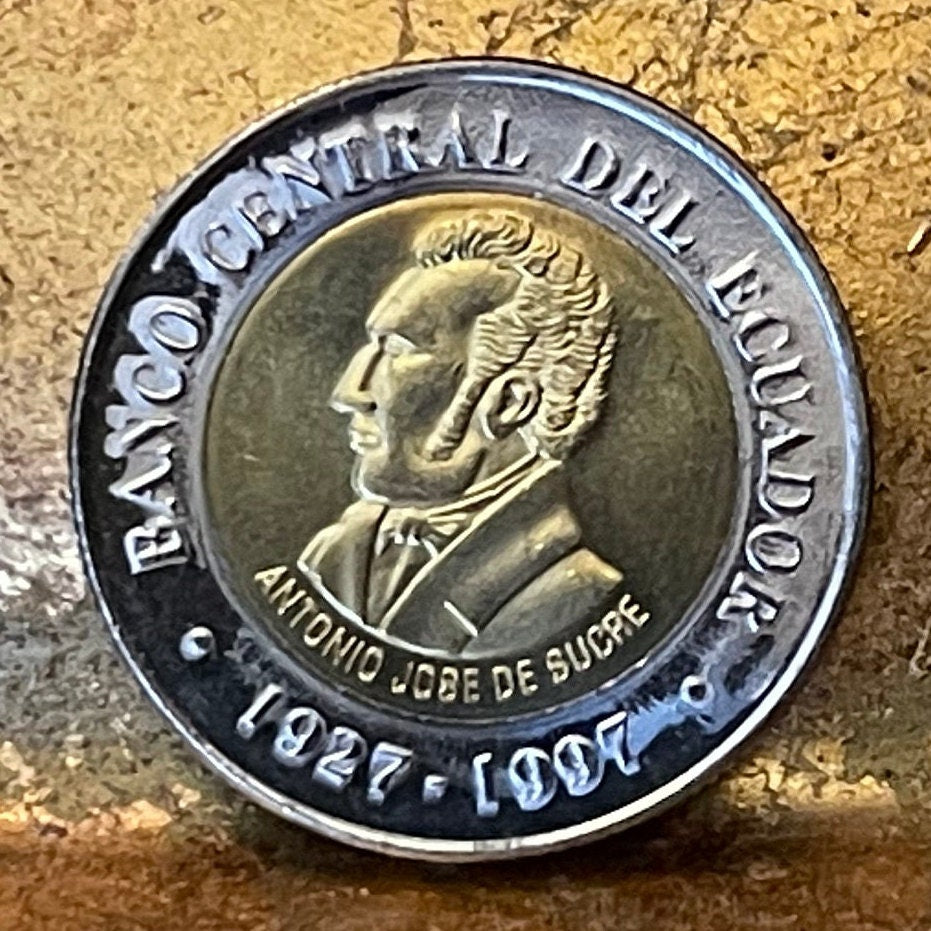elemintalshop
Grand Marshal Antonio José de Sucre 100 Sucres Ecuador Authentic Coin Money for Jewelry (1997) (Bimetallic) (President of Peru and Bolivia)
Grand Marshal Antonio José de Sucre 100 Sucres Ecuador Authentic Coin Money for Jewelry (1997) (Bimetallic) (President of Peru and Bolivia)
Couldn't load pickup availability
Grand Marshal Antonio José de Sucre 100 Sucres Ecuador Authentic Coin Money for Jewelry and Craft Making (1997) (Revolutionary)
Commemorative issue - 70th Anniversary of the Central Bank
Obverse: Portrait of Antonio José de Sucre. Two dates at the bottom, 1927 being the year of creation of the Central Bank, and 1997 -the year of issue
Lettering: BANCO CENTRAL DEL ECUADOR
ANTONIO JOSE DE SUCRE
1927 - 1997
Translation: Central Bank of Ecuador
Antonio José de Sucre
1927 - 1997
Reverse: Denomination in digits, denomination in words (twice)
Lettering: CIEN SUCRES
100
CIEN SUCRES
Translation: One hundred sucres
100
One hundred sucres
Edge: Reeded and plain sections
Features
Issuer Ecuador
Period Republic (1830-date)
Type Circulating commemorative coin
Year 1997
Value 100 Sucres (100 ECS)
Currency Sucre (1884-2000)
Composition Bimetallic: brass clad steel centre in stainless steel ring
Weight 3.55 g
Diameter 19.5 mm
Thickness 1.7 mm
Shape Round
Technique Milled
Orientation Coin alignment ↑↓
Demonetized 10 September 2000
Number N# 1770
References KM# 101, Schön# 94
Wikipedia:
Antonio José de Sucre y Alcalá; 3 February 1795 – 4 June 1830), known as the "Gran Mariscal de Ayacucho" (English: "Grand Marshal of Ayacucho"), was a Venezuelan independence leader who served as President of Peru and as the 2nd President of Bolivia. Sucre was one of Simón Bolívar's closest friends, generals and statesmen.
Due to his influence on geopolitical affairs of Latin America, a number of notable localities on the continent now bear Sucre's name. These include the eponymous capital of Bolivia, the Venezuelan state, the department of Colombia and both the old and new airports of Ecuador's capital Quito. Additionally, many schools, streets and districts across the region bear his name.
******
Assassination
Sucre was killed on 4 June 1830. General Juan José Flores wanted to separate the southern departments (Quito, Guayaquil, and Azuay), called the District of Ecuador, from the Gran Colombia so as to form an independent country and become its first President. General Flores foresaw that if Antonio José de Sucre arrived in Quito from Bogota, he could thwart his plans, since Sucre was very popular due to his reputation as hero and leader in the Battles of Pichincha, Tarqui and Ayacucho. General Juan José Flores put himself in contact with the anti-Bolívar and anti-Sucre leader Brigadier-General and the Commanding General of Cauca, José María Obando, who was not present at Sucre's death but who delegated this criminal act to the Venezuelan Colonel Apolinar Morillo. Commander Juan Gregorio Sarria (who later confessed he had been paid by Obando), José Erazo (a highway bandit and guerrilla fighter), and three peons as accomplices. The plan was to ambush José Antonio de Sucre on the morning of June 4, 1830, in the cold and bleak forested district of Berruecos, along a narrow path that was perennially covered with fog.
The five assassins were hiding behind trees along the part of the trail known as La Jacoba waiting for Sucre's party, which would be passing the area single file. Sucre's retinue comprised seven persons: two muleteers with the baggage, two sergeants, one being the Marshal's orderly, a representative to the Congress from Cuenca, and his[clarification needed] servant, and finally Sucre himself. When Sucre approached La Jacoba, he was struck by three bullets, two inflicting superficial wounds to his head and one piercing his heart. He fell from his horse, which had been shot in the neck, and died almost instantly. His body remained there for twenty-four hours, as his companions, fearful of a similar fate, had fled in panic.
Later, Juan Gregorio Sarria and Colonel Apolinar Morillo confessed that it was Obando who had convinced them to assassinate Sucre. Commander Juan Gregorio Sarria also confessed that Obando had paid him to kill Sucre, since there were anti-Bolivar politicians and officers in Bogota that wanted to see both Bolívar and Sucre eliminated. The ringleader of the anti-Bolívar faction in Bogota was Santander, who was Obando's friend and who had failed in his attempt to assassinate Bolivar. The three peons who were part of the Sucre assassination party were poisoned by Apolinar Morillo to prevent them from testifying about Sucre's murder. In the end, Colonel Apolinar Morillo was convicted and shot in the main square of Bogota for the murder of Sucre on 30 November 1842, and José Erazo died in prison that same year. José Maria Obando was granted immunity due to the fact that he was too powerful in the Cauca Department. Francisco de Paula Santander, although indirectly involved with Sucre's death, was directly involved with Bolívar's attempted assassination and was exiled.
Share










Thank you… very good quality
4 stars review from Shannon









